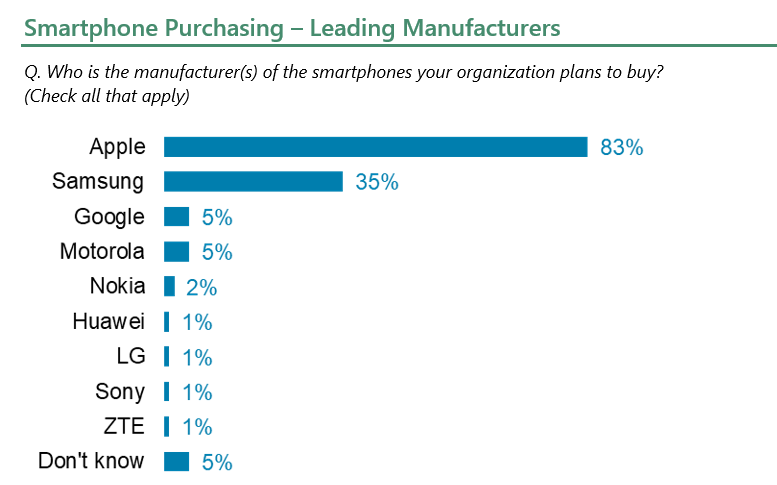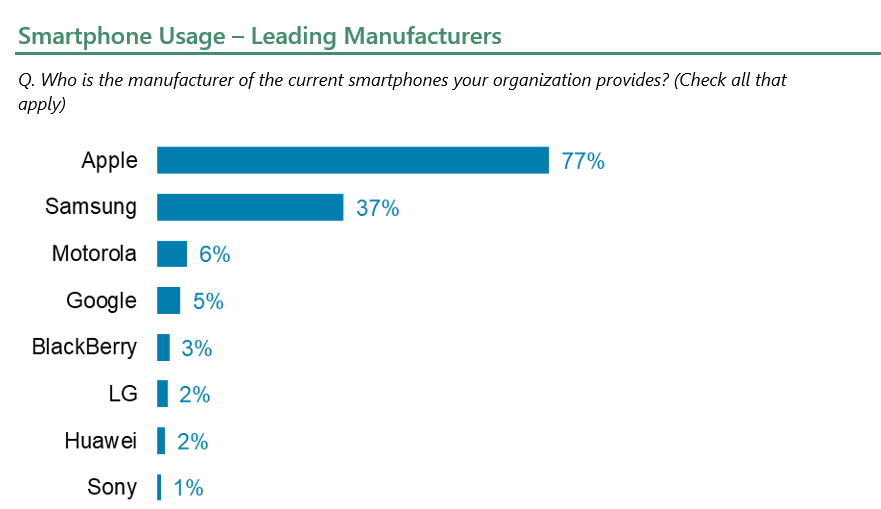
In the 451 Alliance’s May 2021 IT Spending survey, we asked corporate respondents about the latest trends in smartphones. The results provide insights into their companies’ smartphone purchasing plans, current usage and customer satisfaction.
Planned Purchasing
The survey finds a similar spending environment compared to this time last year as overall planned smartphone purchasing (18%) is up only a slight one point compared to May 2020. For context, in pre-pandemic May 2019, 19% of companies planned to buy smartphones for their employees.
While we are seeing slight improvement compared to last year, we are not fully back to pre-pandemic spending. What’s interesting is how narrow the margin is that we’re talking about here because our surveys are not picking up huge swings in smartphone buying. This shows there are a relatively steady number of companies that feel providing these devices to their employees is important regardless of larger economic issues.
Unsurprisingly, the bigger purchasers of smartphones for employees are larger companies (>250 employees; 33%). This compares to only 10% of smaller organizations (<250 employees). Generally speaking, larger companies have more flexibility to update the devices their employees need.
Apple (83%) continues to enjoy tremendous corporate demand, regardless of the fluctuations in overall purchasing plans – and even the fluctuations in manufacturer-specific planned purchases – further solidifying their position as the top smartphone manufacturer for businesses.

Samsung (35%) remains a distant second, although the company is well ahead of Google (5%) and Motorola (5%). Simply put, there continues to be little overall movement within the corporate smartphone market. Businesses’ intent to purchase is controlled by the top two companies, which are well entrenched with huge leads over their nearest rivals.
Among specific models, the iPhone 12 (25%) is the top Apple smartphone that companies plan to buy. Demand for the iPhone 12 Pro (21%) is also solid, followed by the iPhone 11 (16%) and iPhone 12 Pro Max (12%). Importantly, 29% of respondents don’t know which models their company will purchase. The phones that this group ultimately buys will have a material impact on the final tallies for iPhone model demand.
For Samsung, the Galaxy S21 5G series (20%) and the Galaxy S10 series (17%) are the most in-demand models. Just as with Apple, a large number of planned buyers are undecided at this time.
Current Usage
The number of companies providing smartphones to their employees (42%) is actually a bit lower than May 2020 (45%), likely a result of changes to employee needs due to the pandemic and work-from-home policies. In terms of manufacturers, Apple (77%) remains the most popular brand, followed distantly by Samsung (37%). Motorola (6%) and Google (5%) continue to flip flop, yet are still distantly behind the leaders. Notably, only Samsung has increased its share of the business market compared to last year.

A primary reason for Apple’s strong performance is its outstanding customer satisfaction ratings – and this quarter is again no different. Current iOS users are just as satisfied with their phones (94% very or somewhat satisfied) as their biggest rival platform, Android-powered phones (94%). Typically, we see Apple/iOS with a bit of a lead over Android, although the satisfaction ratings do fluctuate from quarter to quarter.
A sudden jump in satisfaction for Android isn’t going to make users flee from iOS devices, because these peaks for Android are inconsistent and many times fleeting. Because Android is spread across multiple manufacturers, it is virtually impossible to get a consistent user experience across these devices. Apple’s closed system creates a more consistent user experience regardless of quarter-to-quarter fluctuations.
Want insights on business technology trends delivered to your inbox? Join the 451 Alliance.

